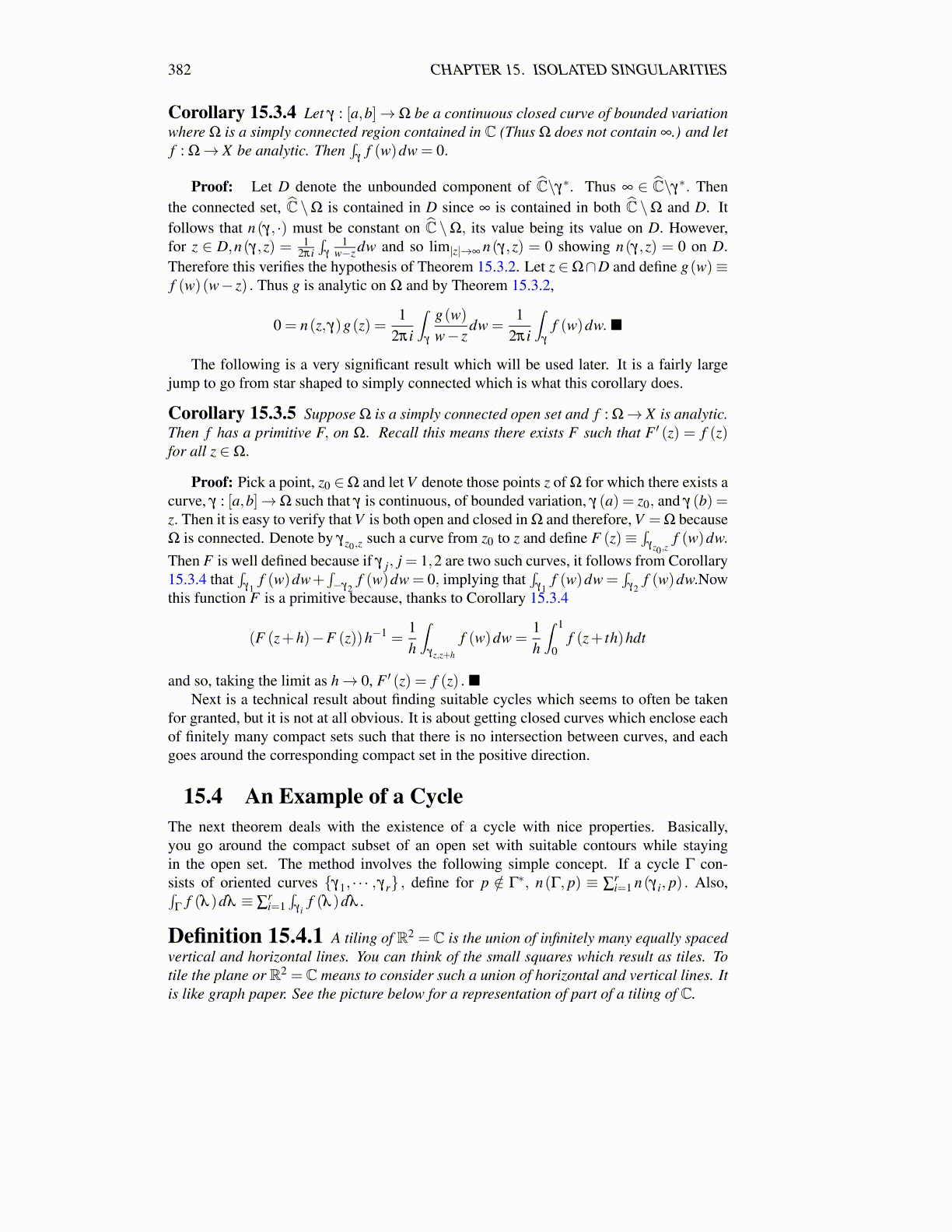
382 CHAPTER 15. ISOLATED SINGULARITIES
Corollary 15.3.4 Let γ : [a,b]→Ω be a continuous closed curve of bounded variationwhere Ω is a simply connected region contained in C (Thus Ω does not contain ∞.) and letf : Ω→ X be analytic. Then
∫γ
f (w)dw = 0.
Proof: Let D denote the unbounded component of Ĉ\γ∗. Thus ∞ ∈ Ĉ\γ∗. Thenthe connected set, Ĉ \Ω is contained in D since ∞ is contained in both Ĉ \Ω and D. Itfollows that n(γ, ·) must be constant on Ĉ \Ω, its value being its value on D. However,for z ∈ D,n(γ,z) = 1
2πi∫
γ1
w−z dw and so lim|z|→∞ n(γ,z) = 0 showing n(γ,z) = 0 on D.
Therefore this verifies the hypothesis of Theorem 15.3.2. Let z ∈Ω∩D and define g(w)≡f (w)(w− z) . Thus g is analytic on Ω and by Theorem 15.3.2,
0 = n(z,γ)g(z) =1
2πi
∫γ
g(w)w− z
dw =1
2πi
∫γ
f (w)dw.■
The following is a very significant result which will be used later. It is a fairly largejump to go from star shaped to simply connected which is what this corollary does.
Corollary 15.3.5 Suppose Ω is a simply connected open set and f : Ω→ X is analytic.Then f has a primitive F, on Ω. Recall this means there exists F such that F ′ (z) = f (z)for all z ∈Ω.
Proof: Pick a point, z0 ∈Ω and let V denote those points z of Ω for which there exists acurve, γ : [a,b]→Ω such that γ is continuous, of bounded variation, γ (a) = z0, and γ (b) =z. Then it is easy to verify that V is both open and closed in Ω and therefore, V = Ω becauseΩ is connected. Denote by γz0,z such a curve from z0 to z and define F (z)≡
∫γz0 ,z
f (w)dw.Then F is well defined because if γ j, j = 1,2 are two such curves, it follows from Corollary15.3.4 that
∫γ1
f (w)dw+∫−γ2
f (w)dw = 0, implying that∫
γ1f (w)dw =
∫γ2
f (w)dw.Nowthis function F is a primitive because, thanks to Corollary 15.3.4
(F (z+h)−F (z))h−1 =1h
∫γz,z+h
f (w)dw =1h
∫ 1
0f (z+ th)hdt
and so, taking the limit as h→ 0, F ′ (z) = f (z) .■Next is a technical result about finding suitable cycles which seems to often be taken
for granted, but it is not at all obvious. It is about getting closed curves which enclose eachof finitely many compact sets such that there is no intersection between curves, and eachgoes around the corresponding compact set in the positive direction.
15.4 An Example of a CycleThe next theorem deals with the existence of a cycle with nice properties. Basically,you go around the compact subset of an open set with suitable contours while stayingin the open set. The method involves the following simple concept. If a cycle Γ con-sists of oriented curves {γ1, · · · ,γr} , define for p /∈ Γ∗, n(Γ, p) ≡ ∑
ri=1 n(γ i, p) . Also,∫
Γf (λ )dλ ≡ ∑
ri=1∫
γ if (λ )dλ .
Definition 15.4.1 A tiling of R2 =C is the union of infinitely many equally spacedvertical and horizontal lines. You can think of the small squares which result as tiles. Totile the plane or R2 =C means to consider such a union of horizontal and vertical lines. Itis like graph paper. See the picture below for a representation of part of a tiling of C.